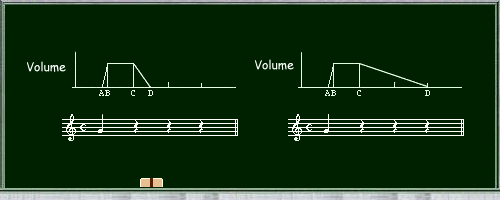Percussion instruments can shorten the length of the resonant period depending on the instrument, but they cannot make it longer. The high range of the xylophone and wood blocks have short resonant periods, while the sounds of bass drums have longer resonant periods.
Originally, resonant periods are the reverberations that remain after a sound is played, so it may feel strange to blow that far, but you should try to give a natural resonant period (or something like it) with your breath, no matter how short the sound, so that you don't stop the sound with your tongue and end up with an unnatural sound without a resonant period.
With wind instruments, you can control the length of the resonant period and the shape of the diminuendo with your breath.
See the example below.

A is the point where the sound begins to come out (you start to play), and the period from A to B°°is from the beginning of playing to the desired volume of sound. From B to C is the time the sound is sustained, and from C to D is the reverberation part where the volume decays.
A to B is drawn quite long in this diagram to make it easier to understand, but it is usually only a moment.
Also, in this diagram, both are sustained at the same volume from B to C, but the volume of this part also changes in actual performance. In the left and right examples, the time the sound is sustained is the same, but the length of the reverberation is different. The nuance of the sound is determined by the change in volume from the onset of the sound to the reverberation.
On the piano, the volume change from A to D is constant and cannot be changed.
For example, let the students listen to the low range of the marimba and have them try to imitate the shape of the sound (volume change) from the beginning to the end on a wind instrument. Imitating the nuances of the marimba sound until it completely disappears on a wind instrument is also great practice for breath control.
Try imitating the sound of a glockenspiel, which has a longer resonance, or a xylophone, which has a shorter resonance.